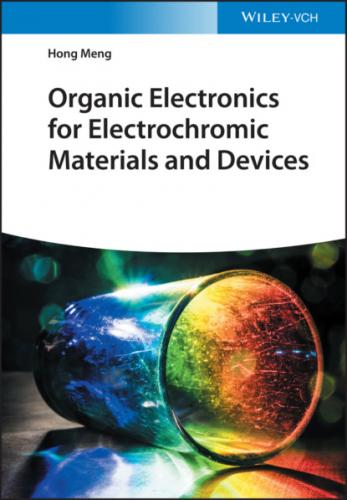where Tphotopic is the photopic transmittance, T(λ) is the spectral transmittance of the device, S(λ) is the normalized spectral emittance of a 6000 K blackbody, and P(λ) is the normalized spectral response of the eye. λmin and λmax define the considered range of wavelengths.
1.3.2 Switching Time
In the context of electrochromism, the switching time (t) can be defined as the time needed for EC materials to switch from one redox state to the other. It is generally followed by a square wave potential step method coupled with optical spectroscopy. Switching time depends on several parameters, such as the ability of the electrolyte to conduct ions as well as the ease of intercalation and deintercalation of ions across the EC active layer, the electrical resistances of electrolytes, and the transparent conducting films. Usually the liquid electrolyte has a lower resistance than the solid electrolyte; therefore the half device and the liquid electrolyte ECD will exhibit a rapid switching than solid ECD. Meanwhile, the large area ECD such as the large smart windows will show a lower switching compared with the small laboratory samples due to the larger electrical resistances of transparent conducting films. However, fast switching is not required in all applications, such as the switchable window technologies; the obvious color change process will increase the fun of user experience. Conversely, the sub‐second magnitude rapid switching is particularly desired for display applications.
Usually the switching times are evaluated at the λmax or 555 nm together with the EC contrast. Therefore there are two kinds of switching time. One is electrochemical switching time, as shown in Figure 1.6a, which is the time required for the current density to change by 90% or 95% between two constant voltages. Meanwhile the switching time of oxidization (toxidization) and reduction (treduction) process can be estimated from this curve. The other is optical switching time (Figure 1.6b), which defines the time needed for the transmittance to change by 90% or 95%. Correspondingly, the coloration switching time (tcoloration) and bleaching switching time (tbleaching) are recorded in this measurement. It is worth noting that the pulse length of potential step has influence in transmittance. A shorter potential step will achieve a smaller contrast, and longer potential will allow EC materials to reach stationary transmittance value in both coloration and bleaching state. But after a certain length, continuing increase the pulse length won't boost the contrast. Therefore the pulse length that just reached the highest contrast are applied to switching time as well as contrast tests.
Figure 1.6 The switching time of EC materials. (a) Electrochemical switching time.
Source: Li et al. [21]. © 2018, Royal Society of Chemistry
(b) Optical switching time.
Source: Hsiao et al. [27].
However, the aforementioned method of switching time is an experiential measurement, which has a difference in varied research groups, such as the different percentage of transmittance change (90% or 95%). Therefore, it is difficult to compare switching time data between different research groups. In recent years, Javier Padilla and coworkers proposed a standard method for calculating EC switching times. They fitted the contrast values as a function of pulse length to the following exponential increase function:
where ΔTmax represents the full‐switch contrast obtained for long pulse lengths and τ is the time constant. If switching time t is equal to τ, 63.2% of the maximum transmittance change is reached. At a time of 2.3τ, 90% ΔTMmax is switched, identically 95% and 99% of ΔTMmax corresponding to 3τ and 4.6τ.
Therefore, for new EC materials, the same chronoabsorptometric responses [28] should be measured and fitted to the aforementioned function. From the fittings, the max values of ΔTMmax (the contrast corresponding to a full switch), the time constant τ, and the corresponding regression coefficient r2 will be obtained. Afterwards the switching time t90% or t95% will be easily calculated. This method allows an easy direct comparison between different reported values.
1.3.3 Coloration Efficiency
Coloration efficiency (CE) plays a fundamental role in the evaluation of the efficiency of charge utilization during the EC processes. It relates the optical absorbance change of an EC material at a given wavelength (ΔA) to the density of injected/ejected electrochemical charge necessary to induce a full switch (Qd). The higher CE value indicates a large transmittance change with a small amount of charge, which makes more effective use of the injected charge. CE value can be calculated using the following equation:
where Tox and Tneut are the transmittances in the oxidized and neutral states, respectively, and Qd represents the injected/ejected charge per unit area, which could be obtained from the integral area of the current density curve during voltage switching (Figure 1.7).
Figure 1.7 The calculation of Qd.
Source: Hsiao et al. [27].
Very similar to the previous parameters contrast and switching time, the CE values are also different depending on the selective wavelength, as shown in Figure 1.8. Several kinds of CE value of the same EC materials are exhibited: in most reported literature, the CE of characteristic wavelength reaching the maximum contrast (λmax) is calculated, which is the maximum CE value (CEmax). Also, the CE value at 555 nm is calculated for comparison in different publishes because of the highest sensitivity of human eyes at 555 nm as well as the photopic CE based on the photopic transmittance mentioned in the contrast part, which considered the light transmission over the wavelength range between 380 and 780 nm normalized with the spectral sensitivity of the human eye. Therefore, more plot of CE values should be obtained rather than single‐valued CE values, to give more information about the performance of EC materials.
